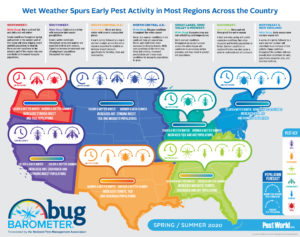Spring is a time for new beginnings, and that includes a fresh start for insect pest populations. Social insects like bees, wasps and termites have been overwintering as single fertilized queens or as colonies with reduced activity. Whether new nests are being initiated or there is a colony revitalization, springtime means these insects are ready to begin foraging and reproducing.
Foraging and nest expansion can impact our clients. Pest management professionals (PMPs) should embrace strategies to interrupt nature’s expansion plan and institute proactive control. Now is the best time to initiate management before populations increase in size and are more difficult to manage. This principle is true for a variety of pests, from ants to rodents to stored product pests.
Before pest populations rebound and establish, PMPs should begin control efforts. Timing can mean everything when it comes to reducing client callbacks and complaints. Consider the following:
- Knowing the history of a client’s past pest pressures will help in determining what pests might be reappearing this spring, and help direct an inspection. Commercial facilities should have those historical records available. In absence of formal documentation, the client can be surveyed for that information — but regardless, a thorough inspection will be required.
- A variety of tools can be useful during an inspection, including bait cards. This tool is often underutilized when it comes to inspecting for ants and their potential impact on a structure. Bait cards can be made using a business card or index card and adding food lures based on known or suspected food preferences of the ants in the area. Honey, dead insects, bacon grease and/or peanut butter (if the client does not prohibit due to allergen control plans) are some typical lures used. Placing multiple cards out in areas of concern can provide information regarding species and potential for pest activity. These are placed on the exterior of the structure, but can also be used indoors. Place cards out at the start of the service; check and remove them before the end of the service. PMPs should act based on what these quick-read monitors are showing.
- Use bait cards and other monitoring tools as early-warning signals of pest activity, and take action. Glue traps, with or without pheromones or lures, can be used for a variety of different pests. Another common monitor is the wood stake baiting monitors commonly used for termite control.
- Visually inspect eaves and other common areas where wasps and other stinging insects may build nests. It is easier to remove and/or treat the area of nest building when populations are low, rather than waiting until when these insects build up worker numbers and become a sting hazard.
- Technology is providing some new ways of predicting pest data. The National Pest Management Association (NPMA) has contracted with a firm, who through analyzing social media searches, develops geographic predictions for different seasonal pests. Although most data are aimed at homeowners, it can have some implications for commercial facilities as well. The NPMA publishes this data under the name “Bug Barometer.” Data for this spring in the Great Lakes region where I live, show warmer, wet conditions, with ticks and ants on the increase. Although the evidence is very anecdotal, pest activity around my household supports these predictions.

Patricia Hottel, BCE
- Several manufacturers of electronic, remote monitoring devices are developing systems — using data generated by their sensors — to predict pest populations. These forecasts can be for a wide geographic region or project trends specific to a client’s site. We may someday be able to prepare for seasonal pests based on an analysis of the data generated by these devices. The capability may be a few years off, but could provide valuable information in proactive pest management.
Contributor Patricia Hottel, BCE, is technical director for South Elgrin, Ill.-based McCloud Services. She can be reached at pathottel@mccloudservices.com.
The post Spring start-ups: Predicting pest pressures appeared first on Pest Management Professional.
from Pest Management Professional https://www.mypmp.net/2020/04/27/spring-start-ups-predicting-pest-pressures/
Sacramento CA

No comments:
Post a Comment